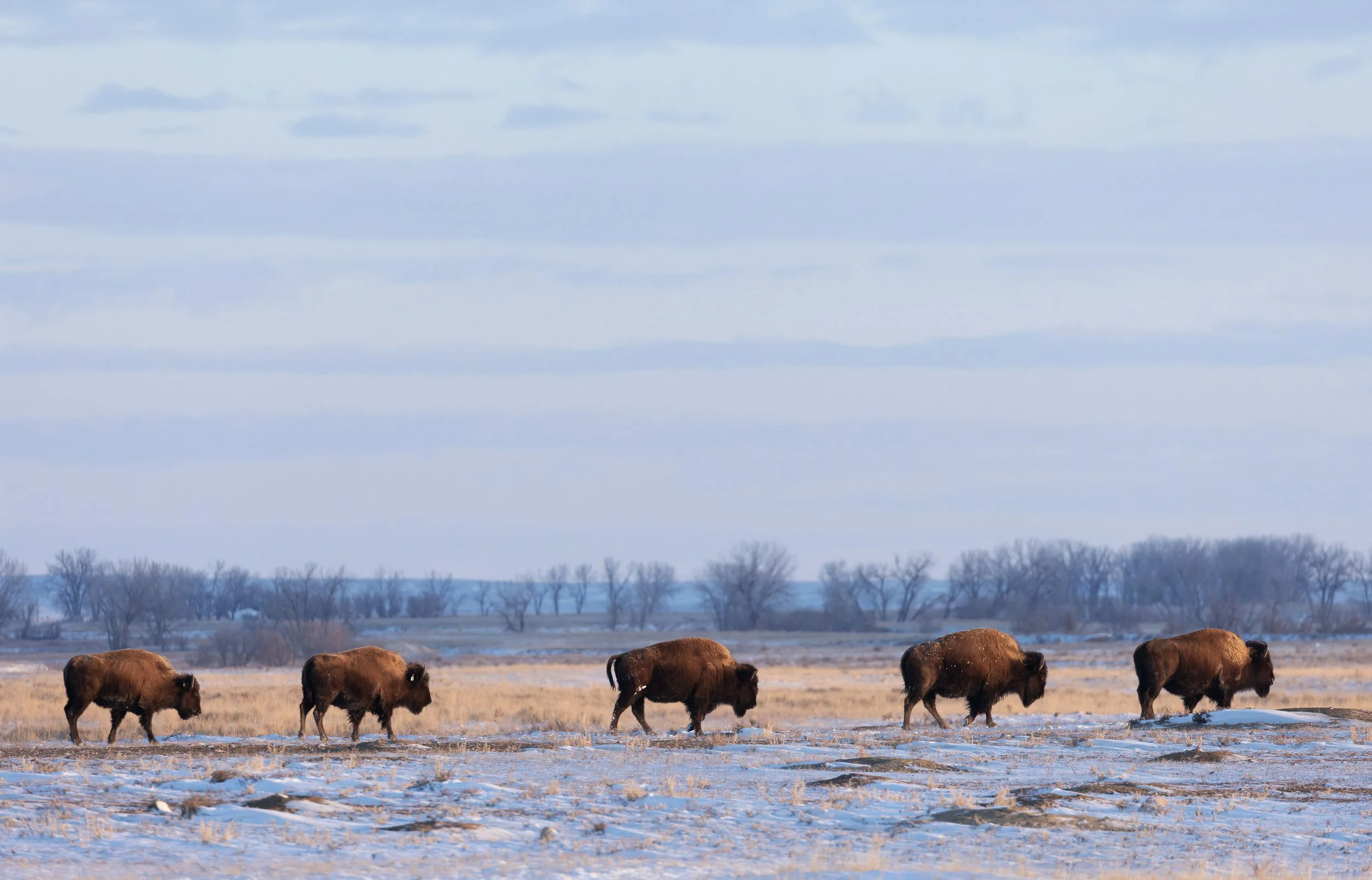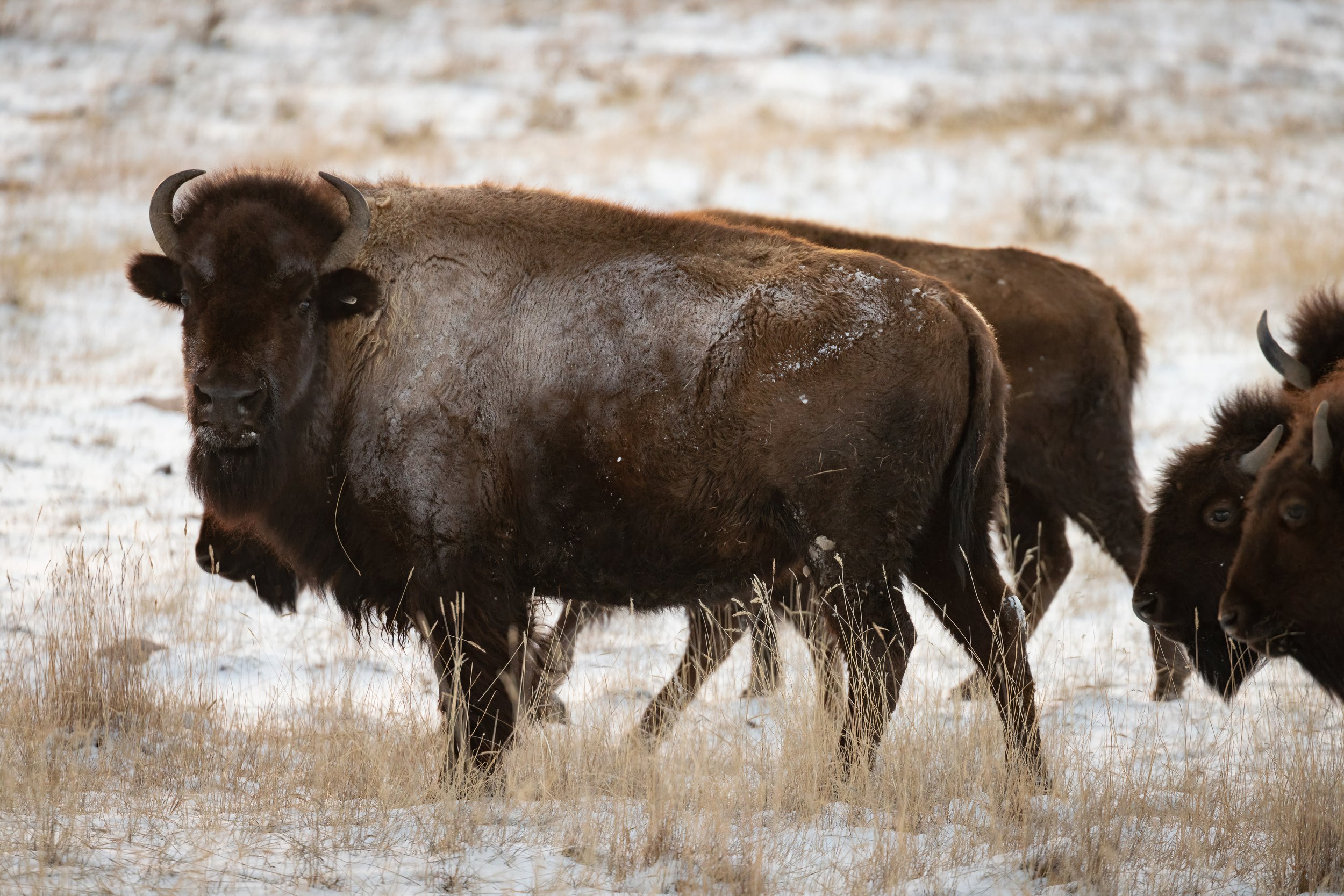GUARDIANS OF THE GRASSLANDS
RESTORING THE AMERICAN BISON
The mystique of the American West drew pioneers and profiteers into a golden expanse where bison once roamed freely. Hunted nearly to extinction, these icons of the frontier now embody resilience—revived by conservationists like American Prairie, working to preserve the wild heart of the Great Plains.
Imagine the American bison running free across vast, long-grass meadows beneath an endless sky. As they thunder across the plains at speeds of up to thirty-five miles per hour, their powerful hooves carve winding paths and create mini estuaries, shaping the land in ways that sustain prairie life. Kicking up dust and scattering seeds, they are not just inhabitants of the grasslands—they are its architects.
In 1870, two massive herds of American bison roamed the central plains, numbering 12 to 15 million. That same year, the Kansas Pacific Railway finished its last section of track needed to connect the coast-to-coast railway network and opened the region to increased settlement. As post–Civil War industrial culture pressed into the prairie, the bison's abundance and versatility led to exploitation by an emerging commercial economy, delighting in bison hides and the thrill of the hunt. Yet beyond the reach of industrial ambition, the bison held far deeper meaning for the Plains tribes, who saw in it not profit, but a venerated provider.
The Plains Indian tribes, the last Native Americans resettled onto reservations, shared a sacred bond with the bison—a symbol of abundance and life. As a great provider, the bison sustained them in every way. The Plains tribes utilized every part of the animal for food, clothing, shelter, tools, weapons, instruments, and sacred objects, honoring and respecting the creatures that made their way of life possible. The bison was a source of sustenance and a cornerstone of their culture and economy.
Among the Kiowa, elders tell stories of bison as protectors of the land, tearing up railroad tracks, trampling gardens, and driving away cattle, to the frustration of settlers. In the vast prairie, where resources like stone and wood were scarce, the bison sustained the independence of nations such as the Arapaho, Cheyenne, Comanche, Kiowa, and Sioux, allowing them to resist the influence of outside forces for as long as possible.
Intent on paving the way for railroads and expansion, the U.S. government sought to relocate Native American tribes to reservations. Recognizing the bison's vital role in the lives of the Great Plains tribes, the Frontier Army adopted a ruthless strategy—systematically killing the bison to weaken the Indigenous peoples. To accelerate this devastation, the Army supplied hunters with free ammunition, aiming to exterminate the bison and, in turn, subdue those who relied on them for survival.
By 1890, the combined forces of Western expansion, commercial harvesting, personal hunting, and warfare had decimated the American bison population. Once an abundant and vital resource for the Plains tribes, the bison were eradicated deliberately, forcing the Indigenous people into dependence on the U.S. government for food and pushing them toward resettlement.
Within a few decades, the bison population that once transversed the windswept grasslands dropped from millions to less than one thousand. As railways and infrastructure reshaped the land, establishing protected parks for tourists became a new priority. And, by 1894, only one remaining wild herd existed—within the boundaries of Yellowstone National Park. In a striking twist of fate, once instrumental in the bison's destruction, the U.S. Army became its protector, managing the small Yellowstone herd and guarding it against poachers.
This paradox reflects a more profound irony in the cycle of destruction and preservation that defined the conservation movements of the turn of the century. Time and again, those who exploited nature for profit or expansion later emerged as its most vocal defenders, working to save what was nearly lost forever.
One such figure was Theodore Roosevelt, who spent years hunting bison in the Dakota Territory before growing an affinity for the animal and the frontier it symbolized. Recognizing the urgency of the bison's plight, he partnered with naturalist William Hornaday and others to form the American Bison Society in 1905. The organization became a driving force in early conservation efforts, working to restore bison populations and ensuring that the great symbol of the American West would not vanish entirely.
Today, fewer than 20,000 bison exist in conservation herds on private, public, and tribal lands. An additional half a million are raised as commodities for commercial purposes across the United States. Meanwhile, less than 30 percent of America's prairies remain intact, making grasslands one of the world's most threatened—yet least protected—ecosystems. To restore this delicate balance, American Prairie, a nonprofit organization headquartered in Lewistown, Montana, is leading the largest grassland preservation project in the United States.
Located in one of the most remote regions in the Lower 48, American Prairie is located across Central and Northeastern Montana. There, wildlife that existed over two hundred years ago still roams—though in smaller numbers. The land owned by the conservation organization serves as a sanctuary not only for native species but also for people seeking to responsibly experience the vast serenity of the grasslands and witness bison and other wildlife in their natural habitats.
Dr. Daniel Kinka, an ecologist and the Director of Rewilding at American Prairie, believes restoring the American grasslands is both hopeful and possible. Today, two restored herds—totaling around 900 bison—roam the reserve as freely as possible. Still considered "near threatened" and "ecologically extinct," the nonprofit carefully manages these conservation herds to allow the bison to fulfill their natural ecological role to the greatest extent possible, shaping the prairie ecosystem as their ancestors once did.
As a keystone species and ecosystem engineer, bison play a vital role in maintaining the health of the prairie. Standing up to six feet tall and weighing as much as 2,000 pounds, they move with force, transforming the landscape. Unlike cattle, which can overgraze if left in concentrated areas, bison roam more widely, selectively foraging on the most tender grasses, weeds, and leafy plants. Spending up to 11 hours a day grazing, they clear paths, create dust wallows that help native grasses take root, and leave behind a patchwork of vegetation that sustains countless other species. Their presence fosters a balanced ecosystem where birds, insects, and other grassland creatures find refuge. In many ways, the very land beneath them depends on their survival to thrive.
Bison, despite their ecological importance, are categorized as livestock according to Montana law. The American Prairie herd grazes approximately 30,000 acres, enclosed by fences modified to be wildlife-friendly. Like any other livestock producer, the organization must pay Animal Unit Month (AUM) fees and taxes to the Bureau of Land Management and the State of Montana. Until bison are reclassified by Montana Fish, Wildlife & Parks, or the U.S. Fish and Wildlife Service as a public resource, they will remain under the same regulations as cattle—despite their critical role in restoring the prairie ecosystem.
Cattle grazing is a cornerstone of the economy in northeastern and north-central Montana, and the American Prairie's bison herds have coexisted successfully alongside neighboring cattle operations for decades. Through strategic partnerships with Tribal, state, and federal partners and land acquisitions, the organization is expanding bison habitat and working to rebuild a fully functioning prairie ecosystem that supports both wildlife and local communities.
Research, such as the findings outlined in the Vermejo Statement, suggests that a self-sustaining herd would require at least 5,000 bison. If achieved, a herd of that size would significantly accelerate the ecological recovery of the prairie. Estimates indicate that tens of thousands of bison could again thrive on the organization’s ambitious 3.2-million-acre vision- a goal American Prairie remains committed to until the species fully recovers in its native range.
Each acre acquired by American Prairie moves conservation beyond the traditional "fortress-style" model, fostering a landscape where wildlife and people coexist. The goal is to protect bison and restore the prairie, ensuring the land, its species, and the people who cherish it can thrive together. When free to roam in its rightful place, the bison is an invaluable force of ecological renewal.
The future of the American bison and the vast grasslands they help sustain depends on our willingness to restore and protect large expanses of the interior west. As efforts like those of American Prairie reconnect fragmented landscapes and revive free-roaming herds, they do more than safeguard a species; they breathe life back into an entire ecosystem. By restoring our collective connection to this iconic animal and embracing its legacy as a symbol of the American West, we take part in a conservation story still being written—one that ensures the guardians of the grasslands continue their role in shaping and sustaining the land for generations to come.



